Over the past few years, the prices of indoor air quality monitors have dropped significantly. Even when I started this blog a few years ago, the most affordable monitors that were accurate started at a couple of hundred dollars or more. Luckily, prices have gradually dropped over the years, and we now have many affordable options under $100.
Amazon and IKEA are the two most recent companies to enter the market. Both provide low-cost options and bring indoor air quality monitoring awareness to millions. However, while these two brands have brought new products to the market, other players are already in the indoor air quality space. Some brands, including INKBIRD, an IoT company based in China, have been making these monitors for years.
I recently reviewed one of INKBIRD’s products, a carbon dioxide monitor named the IAM-T1 and found it a very appealing product that rivals the gold standard of carbon dioxide monitors, the Aranet4. Today, however, I want to look at a very different product – the INKBIRDPLUS 6-in-1 PTH-9A Indoor CO2 Detector. Since the name is quite long, I will refer to the device as the INKBIRD 6-in-1 Monitor in this article.
The INKBIRD 6-in-1 Monitor is a ‘dumb’ indoor air quality monitor because it doesn’t have the connectivity or a supporting application we often see in other monitors. Instead, this monitor is designed to be a standalone device that can sit on your desk, in your kitchen, or in your bedroom and provide insights without needing a smart device.
Of course, this carries benefits and downsides, which we will dive into in today’s article. On top of this, we will also be answering other important questions, such as ‘Is the device accurate?’ or ‘Is it worth the price?’. If you’ve been considering purchasing an INKBIRD 6-in-1 Monitor, you’ve come to the right place because today, I will discuss everything you need to know about this interesting product.
If you’re curious to read about other air quality monitors, you can also check out my article on the best air quality monitors you can find right now. These are the best monitors in each category (portable, desk-based, all-round, etc.) from my experience, and the article will help you find the perfect air quality monitor for your needs.
Subscribe to BreatheSafeAir
We spend 90% of our time indoors. Make sure the air you breathe indoors is healthy.
This post contains affiliate links. For more information, please refer to my affiliate disclaimer. I was sent a product for review, but the article is not sponsored. All opinions expressed in this post are my honest thoughts. I only recommend products that I genuinely believe in.
Information on this blog is for informational purposes only. Readers are encouraged to confirm the information herein with other sources. Furthermore, this information is not intended to replace medical advice from professionals. This website assumes no responsibility for the accuracy of the information, and information is subject to change without notice. Devices mentioned on this website are not medical devices and do not guarantee protection.
Sensors & Accuracy
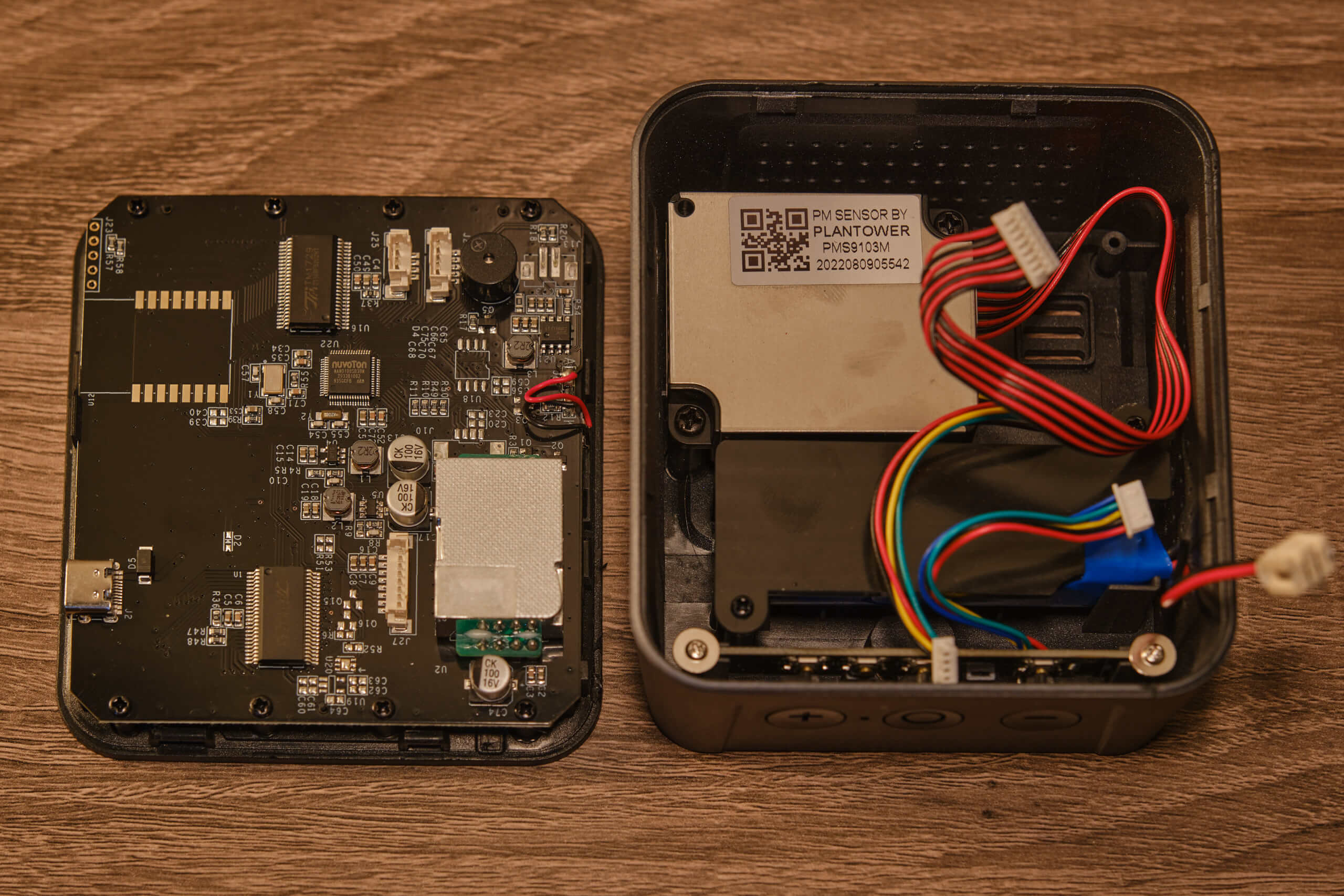
Accuracy is the most important aspect of any air pollution monitor, and it is, unfortunately, where I encountered some issues with the INKBIRD 6-in-1 Monitor. Before I discuss those, however, let’s take a look at what the INKBIRD 6-in-1 Monitor can monitor:
- PM2.5
- PM10
- CO2
- Temperature
- Relative Humidity
It measures these variables with three sensors – a PLANTOWER PMS9103M for PM2.5 and PM10 readings, a Winsen MH-Z19D for carbon dioxide readings, and a temperature and relative humidity sensor that I haven’t been able to identify (but have been told is from a Swiss company). While PLANTOWER sensors are generally considered accurate, they tend to be lower cost than some other companies.
While I know less about the Winsen carbon dioxide sensor, this fantastic guide indicates they are accurate. Unfortunately, despite being accurate, I’ve encountered some issues with this sensor, but more on that in a second. The takeaway here is that the sensors used inside the INKBIRD 6-in-1 Monitor are generally trustworthy. However, let’s take a look at my experiences with the device.
While I lack a reference monitor to compare the PM2.5 and PM10 readings, I have access to a wide range of accurate carbon dioxide, temperature and relative humidity sensors, which I can use as a point of comparison. However, while I don’t have a reference monitor, I have my uHoo monitor, which I could use to compare PM2.5 and PM10 readings on the INKBIRD device.
In most cases, the INKBIRD 6-in-1 Monitor performed well in these readings. While it tended to react quickly to minor air quality changes and over-report these changes, it tended to be accurate within 10% for PM2.5 and 20% for PM10. While this does leave some room for variability, it is easily accurate enough to pick up trends and alert the user to them.
Of course, the uHoo isn’t entirely accurate and has similar accuracy (or inaccuracy) as it’s just a consumer-grade monitor. From these results, I would conclude that while neither the uHoo or INKBIRD devices are entirely accurate, both report close enough to the trends that the user can draw conclusions from them.
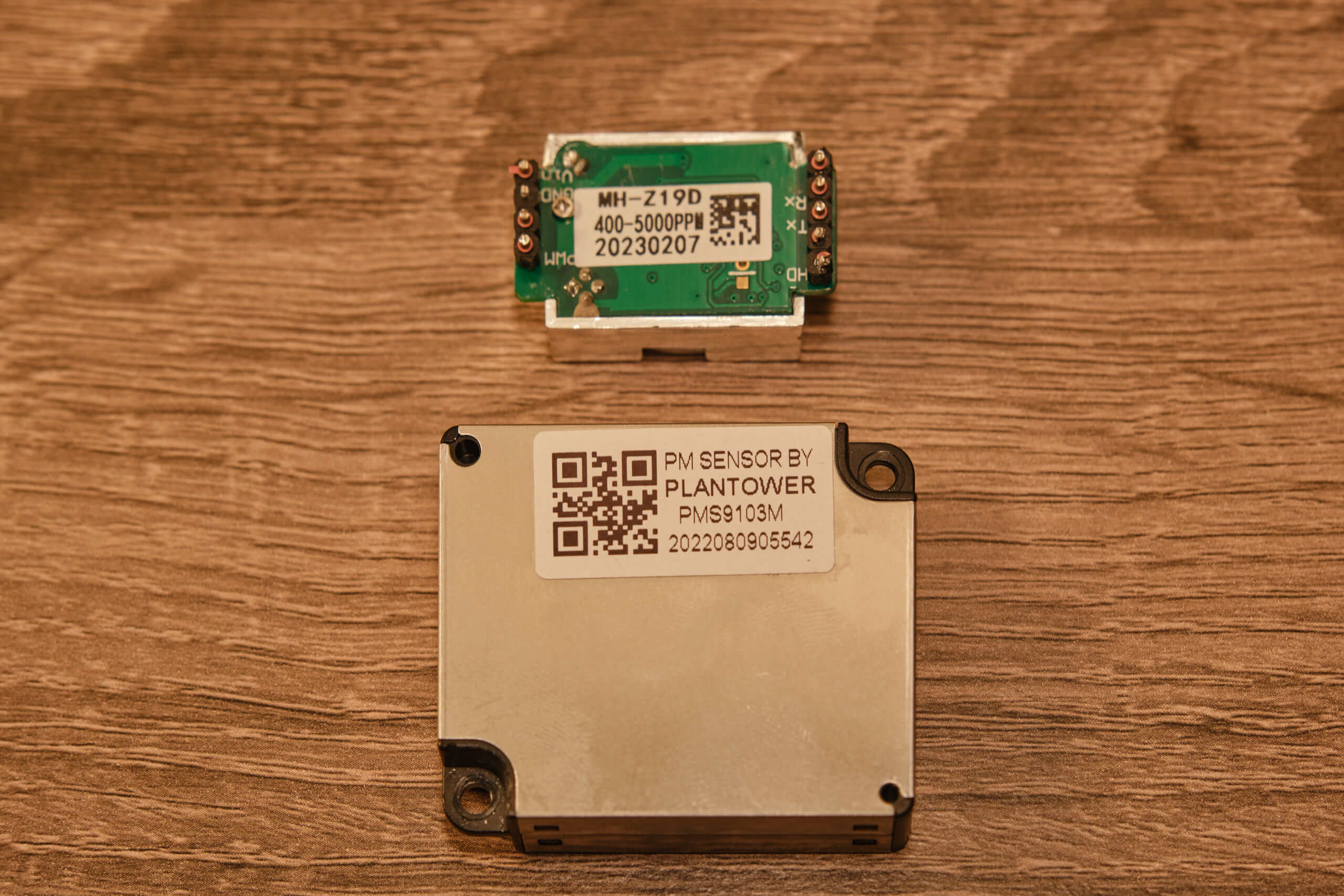
Unfortunately, my device had issues when it came to the accuracy of the carbon dioxide sensor. On the first day, I had the device, it recorded very accurately, often giving the same or similar readings to my accurate Aranet4 and even the INKBIRD IAM-T1 carbon dioxide monitor. This was a promising start!
Unfortunately, after a few days, the readings became wildly inaccurate, and the device regularly reads three or four hundred parts per million under the Aranet and IAM-T1. For example, I currently have two Aranet4 Homes reading 1500 and 1505 ppm, while my 6-in-1 Monitor is reading 1034 ppm. Interestingly, this reading is consistent in how far below it reads, making me believe it has an accurate sensor, but there is an issue with the calibration.
However, while the device allows for manual calibration, no matter how many times I calibrate it, this issue persists. I have tried calibrating the CO2 sensor in the device over ten times in the past few weeks, and I can’t get it to be accurate again. Even when I calibrate my Aranets right next to it (simultaneously), they vary wildly as soon as the calibration process is complete.
I also believe there is some rather aggressive auto-calibration going on with this monitor as sometimes it will consistently underreport by 500 ppm, while at other times it will be 300 ppm. If you want to learn why auto-calibration can be an issue, please refer to my review of the Vitalight Mini CO2 Detector. From what I’ve learnt about the sensor, the MH-Z19D auto-calibrates itself every 24 hours.
The issue is that without an accurate CO2 monitor, you wouldn’t know the INKBIRD is inaccurate. This creates a false sense of trust in the device, which can be detrimental to your health and mental well-being over the long term. For this reason, I am very cautious regarding the stated carbon dioxide concentrations on the INKBIRD 6-in-1 Monitor.
Since the device recorded identically to my other devices for a couple of days after turning it on, I know it can be accurate. However, no matter what I do, I can’t get the device to be accurate again – at least concerning CO2 measurements. I don’t know if this issue is isolated to my device or is widespread across devices. Unfortunately, I can’t recommend the INKBIRD 6-in-1 Monitor as a carbon dioxide monitor without trying more of these models to see if this is an isolated issue.
So, what about the final two sensors? From my experience, the relative humidity sensors in the INKBID 6-in-1 Monitor are relatively accurate. While the relative humidity may be a few percent different, it always reads within a few percentage points of my Aranet2, Aranet4 Home, and INKBIRD IAM-T1 monitors.
Unfortunately, I can’t say the same for the temperature readings. At least on my device, the temperature always reads 1-2 degrees Celsius higher than my other devices. For example, as I sit here writing this, my three Aranet products read 25.6-25.8 degrees Celsius, and the INKBIRD IAM-T1 reads 25.4. At the same time, the INKBIRD 6-in-1 Monitor is reading 27 degrees – quite a big difference! While I expect some variation (as seen in the other monitors), this is usually within a few decimal points, not over a degree!
If I had to guess the cause, it is likely because the INKBIRD 6-in-1 Monitor generates internal heat due to all of the included components. While each device generates some heat, the 6-in-1 Monitor likely generates more due to the extra sensors. This wouldn’t be a problem, but unfortunately, the temperature sensor seems to pick up this difference. For this reason, I always remove a degree or two from the reading of the INKBIRD product to get a more accurate temperature.
Purchase INKBIRD 6-in-1 Monitor
Features

The INKBIRD 6-in-1 Monitor is relatively sparse when it comes to features. Unlike other air pollution monitors in the same price range (such as the Qingping Air Monitor Lite), the INKBIRD device doesn’t have any form of connectivity and, therefore, no accompanying app.
The biggest feature of the device is the large, clear display which dominates the front of the 6-in-1 Monitor. I will dive into more details regarding the screen in the design section, so please continue reading if you’re interested in how the screen performs in real life. While the screen is the device’s main feature, it has a few other features worth discussing.
As can be seen on the display of the device, the INKBIRD 6-in-1 Monitor has three AQI stages – the green section (0-50), yellow (50-100) and red (100+). These three levels can’t be adjusted. The device also has a loud alarm that can be toggled on or off but that can’t be adjusted. This alarm is always tied to the red level and will activate whenever the device records an AQI above 100. While including an alarm is nice, it would be far more helpful if it was user-adjustable.
Another useful feature of the INKBIRD 6-in-1 Monitor is the ability to calibrate the CO2 sensor. This can be done by powering off the device and then holding down all three buttons. This will start a 200-second countdown, in which the device should be placed outside (or in a well-ventilated area). Once this countdown is complete, the carbon dioxide sensor will be recalibrated, setting a new baseline for 410 ppm (the value the monitor calibrates to).
The other sensors can’t be calibrated, meaning that over time, they will drift and lose accuracy. While the carbon dioxide sensor is the most prone to drift, these other sensors will also drift over time, gradually losing accuracy over months and years of use. While this shouldn’t cause much of an impact in the short term, it may cause readings to become inaccurate over time.
Other than these, the only other feature of the device is the ability to set the date and time. This is handy if you plan to use the device as a replacement for a bedside clock. While it’s not as important in other use cases, it is nice to have it because when is having the date and time a disadvantage?
Overall, the INKBIRD 6-in-1 Monitor has few features, which can be viewed as an advantage or disadvantage. The device does a great job if you want a simple monitor that can be left alone and just referred to when needed. However, if you want more features, such as the ability to view historical data, you will have no choice but to pick another monitor.
I don’t see this lack of features as an issue in isolation. However, when you compare it to other monitors on the market, such as the similarly priced Qingping Air Monitor Lite and the even cheaper monitors from Amazon and IKEA, it’s hard to justify this lack of features. All of these other monitors offer connectivity, and they have a far better feature set included.
Purchase INKBIRD 6-in-1 Monitor
Design

The INKBIRD 6-in-1 Monitor is a simple device and this can be felt in the design of the product. With this said, while it’s simple, it has everything required to perform its essential function – to keep an eye on your indoor air quality and inform you when you need to take action due to poor indoor air quality.
The device’s most important part is the screen, which dominates the front of the monitor. The screen is very large and provides all of the data from the device – this includes the time, sound and battery indicators, and readings for the current temperature, humidity, PM2.5, PM10, CO2 and AQI.
In the centre of the screen, you will see a circle with three sections. Each section is colour-coded either green, yellow or red to correspond to the current AQI in the room. While it’s a bit hard to see at times, a little white line points to the current air quality status (in the image above, you can see this line to the top-right of the 2 in 062). If you prefer numbers, there is also a large AQI reading in the circle’s centre.
While I appreciate the visual approach, I wish INKBIRD had gone with a meter similar to their IAM-T1 CO2 monitor. While it might not look as visually appealing, the bar on the IAM-T1 is far more quickly readable, and I found it easier to interpret. While the approach on the 6-in-1 Monitor isn’t bad, it can be hard to find the little white line if you’re viewing the device in a bright room or at an angle.
Below the AQI reading, you will find the individual measurements for fine and ultrafine (PM10 and PM2.5) particles, alongside CO2, temperature, and humidity. I appreciate having these readings shown individually as, while AQI is a good indicator, it often leaves a lot to be desired when it comes to identifying individual pollutants. Of course, it’s important to note that CO2 isn’t incorporated in AQI, so this reading needs to be monitored separately.
Overall, the layout of the display is fine. I don’t have any good or bad thoughts on it, as it performs its job well, but it isn’t flashy or anything particularly standout. Compared to a device such as the Qingping Air Quality Monitor, I am not left impressed, but I also don’t have anything particularly negative to say about it.
Perhaps the only negative I had about the screen was the brightness. The screen is backlit and easily readable in darker rooms and at night. However, during the day, or even in a bright room with lots of sun or bright lights, the screen can be tough to read – especially if viewing it from an angle. This isn’t a deal-breaker, but this is a significant disadvantage for a device where the screen needs to be viewed regularly due to a lack of connectivity.
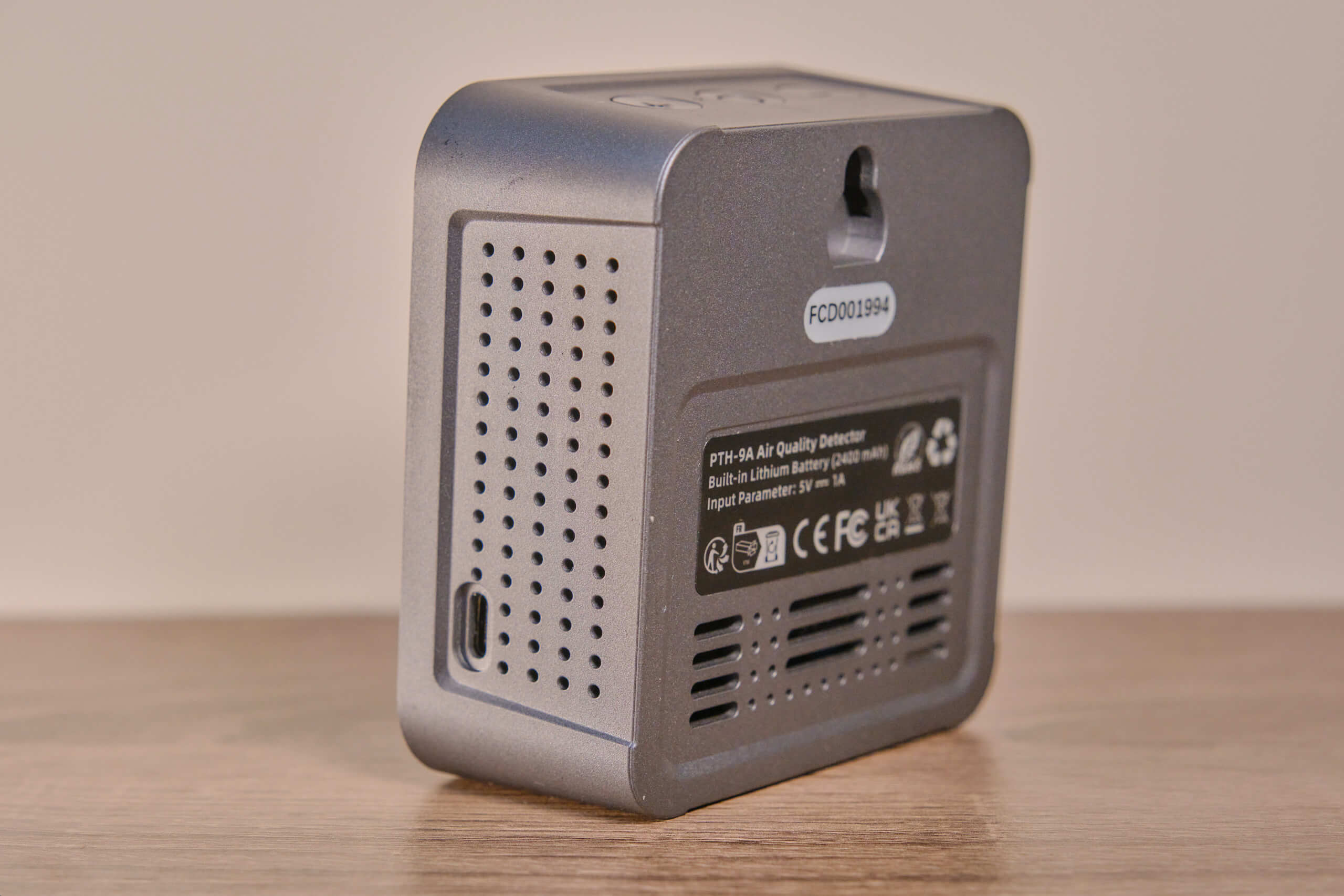
The back and sides of the device are similarly minimalist. On both the bottom and left sides, there is nothing of note. On the right side, you will find the Type C port for charging the device’s internal battery. The port placement is inconvenient, and I wish it were on the back of the device instead. Being on the right of the device means that unless you have a 90-degree Type C cable, the cable will be easily visible.
I wish this port were on the back of the device as it would make it much easier to hide a cable and help keep my desk or table looking clutter-free. With that said, I believe the decision to put this port on the side of the device was because, as shown by the hook mount in the back of the monitor, it is intended to be used as either a desk-based monitor or a wall-mounted one.
If you mount the monitor on the wall, having the Type C port on the side of the device makes much more sense. While it would look cleaner on the bottom of the device, it obviously wouldn’t work on a desk. The placement of the port means the device works either as a wall-mounted monitor or as a desk-based monitor, but it isn’t particularly designed for either use. I wish the device had an inlaid port similar to the IKEA air pollution monitor, as this would work in both situations and look tidier.
This is a minor issue, and it doesn’t impact functionality at all, but for people who value tidiness, such as myself, this is a bit irksome. Besides this port and the hook mount on the back, the device has nothing else worth noting. There are many vents across the device to allow for air to flow into the device, but these are rarely visible when you have the device on a desk or mounted to the wall.
While I’ve used this device as a desk and semi-portable solution, I could see it being a great monitor to have mounted to a wall. The screen is large, and you rarely need to interact with the device. For this reason, I could see it being a good low-cost solution for areas where you want the air quality to be displayed publically (such as in a cafe).
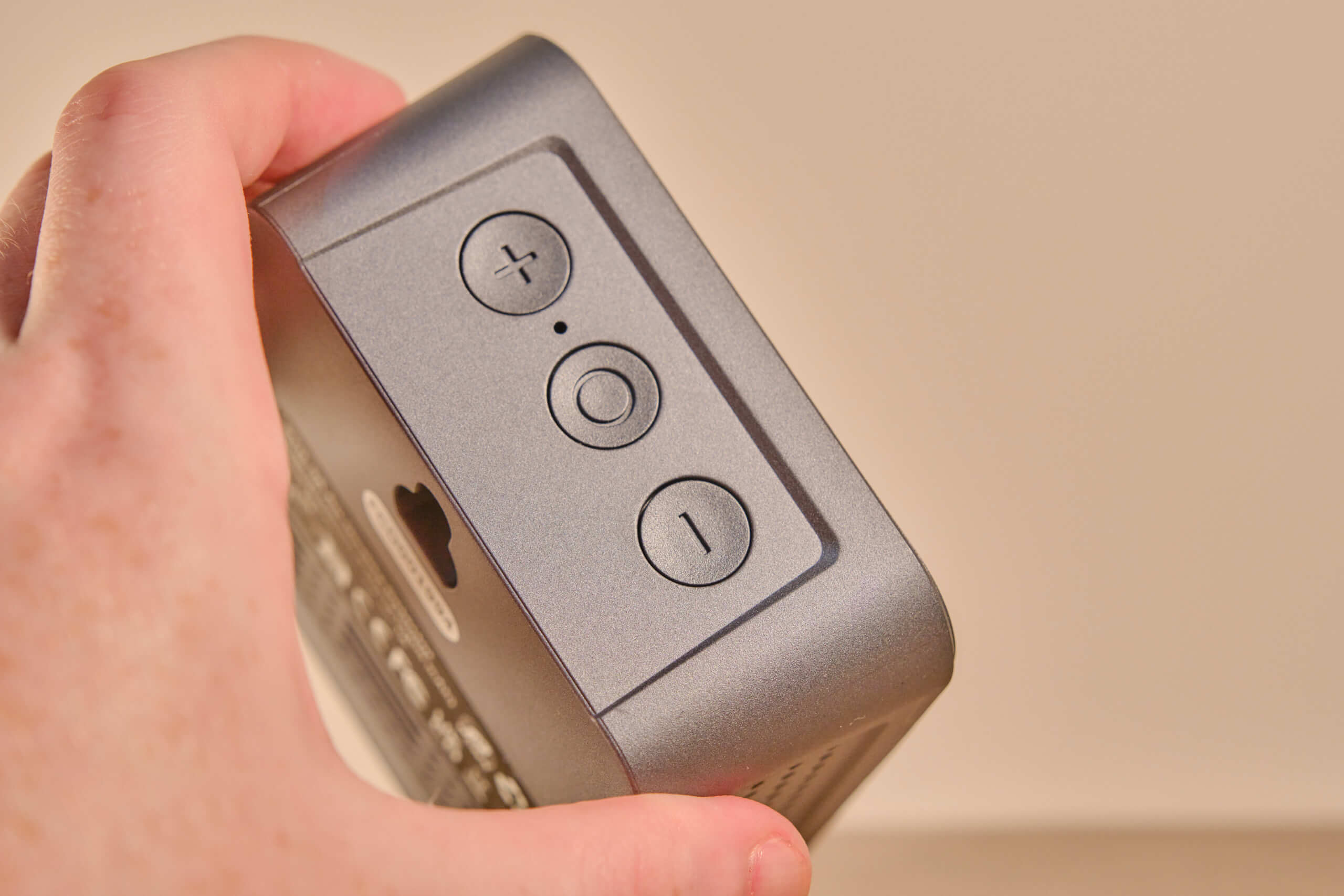
The final area of the device we need to look at is the top. On the top of the INKBIRD 6-in-1 Monitor, you will find the three buttons that you will use to interact with the device. These are the only ways to change the device’s settings, so you will find yourself using these occasionally – especially during the setup process.
While the button control scheme can be a bit confusing (especially without the manual handy), I didn’t have any issues with the functionality, and the buttons make a nice click when used. While they feel like plastic (which they are), they have a tactile click and are responsive.
It’s worth mentioning that while the INKBIRD 6-in-1 Monitor does have an internal battery, it isn’t made to be portable. It’s a large device, and compared to a portable air quality monitor such as the Atmotube Pro, it’s quickly apparent that this device is not made to be portable. However, the inclusion of a battery is nice for a few reasons. Firstly, it allows you not to lose data through power loss, and it also allows you to move the device around your house and take readings in other locations when needed.
Purchase INKBIRD 6-in-1 Monitor
Pricing

At a regular retail price of $89, the INKBIRD 6-in-1 Monitor is one of the market’s less expensive air-quality monitors. This is especially true considering that most cheaper monitors contain only either a particulate (PM2.5 or PM10) sensor or a carbon dioxide sensor.
However, it is also a direct competitor to a fantastic air pollution monitor in the Qinqping Air Monitor Lite at this price. With an identical regular retail price, the Air Monitor Lite is a fantastic device with good accuracy and a full suite of features. It has great connectivity, and the app allows the user to customise a variety of settings on the device.
For this reason, I would recommend that most users get the Qingping monitor. At the same price, it is far more feature-filled, and it’s also more accurate. With that said, you need to use the accompanying app to get the most out of the device, so if you’re looking for an easy-to-use device that you can leave alone most of the time, the INKBIRD 6-in-1 Monitor might be the better choice.
If the device is on sale for a significant amount under the regular retail price, then the 6-in-1 Monitor becomes a far more tempting offer. However, at the standard price, there are other great options that I would opt for instead.
Purchase INKBIRD 6-in-1 Monitor
Conclusion
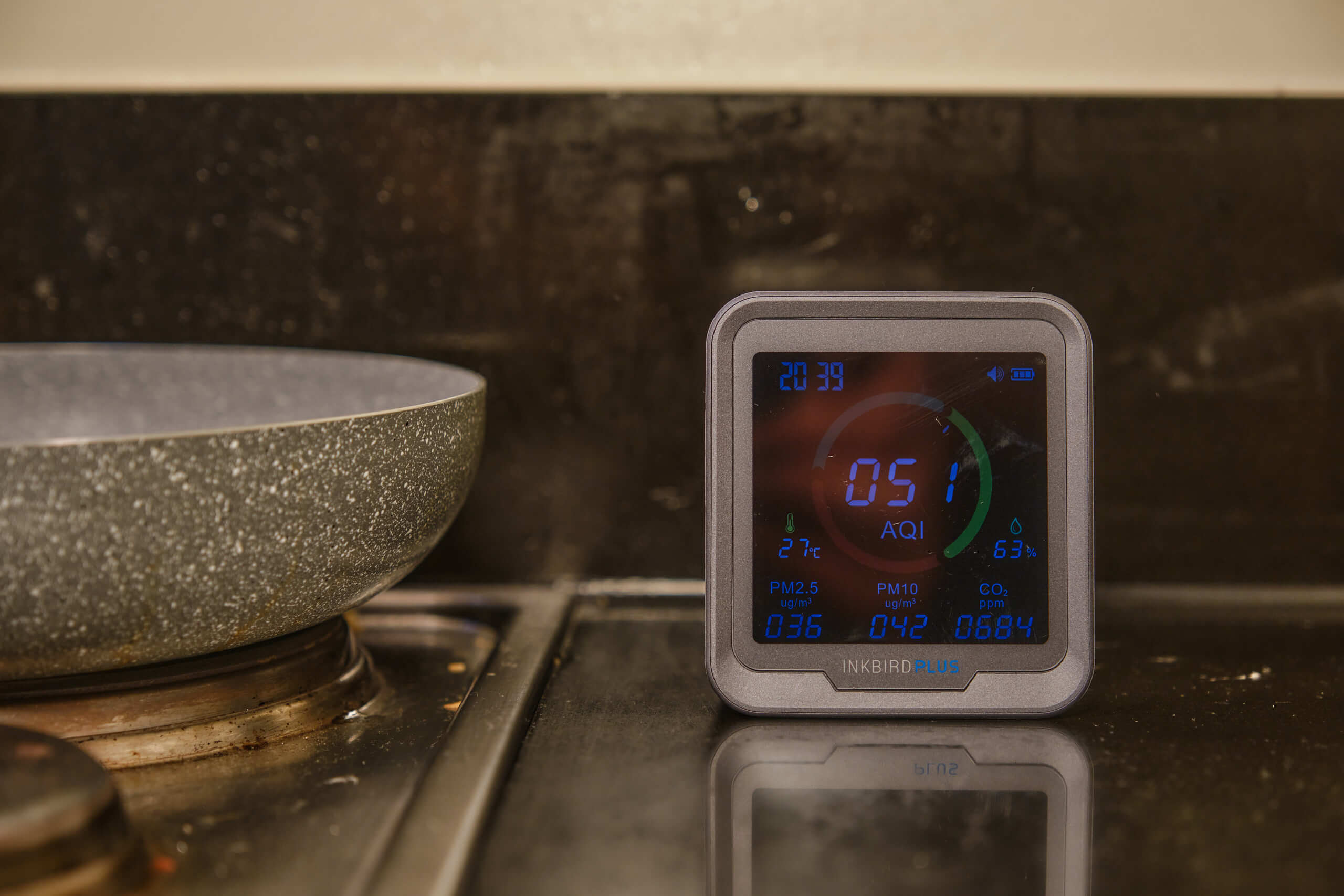
The INKBIRD 6-in-1 Monitor is an inexpensive air-quality monitor intended to be placed somewhere in your home or office. It has a large screen, is very easy to use, and has all the essentials that you would expect in a device in this category.
Unfortunately, it also has a few issues that I can’t look past. Firstly, the carbon dioxide sensor has calibration issues that have rendered it unusable for me. Is this issue isolated to my device? I’m not sure. However, it’s an issue that persists no matter how I try to right it.
Furthermore, the temperature sensor is also not particularly accurate, and I believe this is due to the heat generated by the device. Where all my other devices currently show a temperature between 24.3 degrees Celsius and 24.8 degrees, the INKBIRD 6-in-1 Monitor is reading 26 degrees.
Finally, the pricing isn’t quite right. At this price, the Qingping Air Monitor Lite is an air-quality monitor with far more features that comes in at the same retail price. With the added connectivity, fantastic application, and more accurate sensors (at least in my experience), the INKBIRD product is hard to recommend against it.
That said, I could still see a use case for the INKBIRD 6-in-1 Monitor for anyone who wants a simple monitor for particulate matter. Of course, I can’t recommend it for monitoring carbon dioxide, but the particulate matter readings appear relatively accurate for both PM2.5 and PM10. If the product goes on sale, this could be a great monitor to place in a garage, bedroom, or office.
Have you used the INKBIRD 6-in-1 Monitor? What was your experience with it? I would love to hear from you if you have used the monitor. Especially in regards to the carbon dioxide sensor – is this an issue exclusive to me, or is it a common issue with this monitor?
Purchase INKBIRD 6-in-1 Monitor
INKBIRD 6-in-1 Monitor FAQ
What Does the INKBIRD 6-In-1 Monitor Monitor?
The INKBIRD 6-in-1 monitor monitors PM2.5, PM10, carbon dioxide, temperature, and relative humidity.
Is the INKBIRD 6-In-1 Monitor Accurate?
For particulate matter and relative humidity, yes. However, I found the temperature and carbon dioxide measurements inconsistent with other devices.
Where Can I Buy the INKBIRD 6-In-1 Monitor?
You can purchase it from the INKBIRD website or Amazon.
What Alternatives Are There to the INKBIRD 6-In-1 Monitor?
At this price, the Qingping Air Monitor Lite is the best alternative.
What Features Does the INKBIRD 6-In-1 Monitor Have?
The INKBIRD 6-in-1 Monitor features a large screen, an internal battery, and a range of different sensors to let you know how your indoor air quality is.
Have Questions or Comments?
Join the discussion on the BreatheSafeAir Community Forum. Ask any questions you have about air quality or adjacent topics and get quick answers!
INKBIRD 6-in-1 PTH-9A
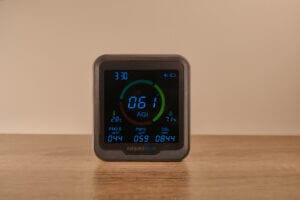
I recently reviewed one of INKBIRD’s products, a carbon dioxide monitor named the IAM-T1 and found it a very appealing product that rivals the gold standard of carbon dioxide monitors, the Aranet4. Today, however, I want to look at a very different product - the INKBIRDPLUS 6-in-1 PTH-9A Indoor CO2 Detector. Since the name is quite long, I will refer to the device as the INKBIRD 6-in-1 Monitor in this article.
Product Brand: INKBIRD
2
Pros
- Relatively accurate PM2.5 and PM10 readings
- Particle, carbon dioxide, temperature, and relative humidity sensors
- Large screen
- Easy to use
- Features manual carbon dioxide calibration
- Type-C charging
- Internal battery (with a short life)
- Mutable speaker
Cons
- Inaccurate carbon dioxide sensor
- Temperature sensor consistently too high
- No connectivity
- Hard to view in direct light
- Automatic carbon dioxide sensor calibration
I found your review too late! I had just purchased an Inkbird Plus and was reading your review as it shipped my way.
Unfortunately, I found a lot of the same problems, with the CO2 up to 200 PPM short of an Aranet4 in the same space and PM2.5 around 10 PPM less (which is way too much variance for PM.5) and the humidity was 10% higher. For general air quality trends, it might be a cheap option, but I had to return our monitor because it’s not helpful for real-time measurements.
Thanks for your detailed review!